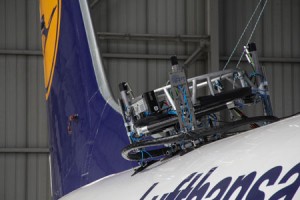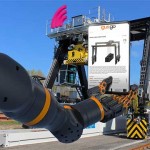Igus reduces mobile robot weight by 15%
 Safety is particularly important in air travel, both on the ground and in the air. For this reason, aircraft are regularly inspected and maintained. An important item on the inspector’s checklist is looking for signs of corrosion and metal fatigue on the outer skin of the aircraft. To reduce ground handling times and to increase safety through improved maintenance, Lufthansa Technik AG developed a robot-supported process for inspecting metallic aircraft fuselage structures, called MORFI (Mobile Robot for Fuselage Inspection). One of the key design criteria for the mobile robot was its overall low weight, which is why igus bearing technology is used.
Safety is particularly important in air travel, both on the ground and in the air. For this reason, aircraft are regularly inspected and maintained. An important item on the inspector’s checklist is looking for signs of corrosion and metal fatigue on the outer skin of the aircraft. To reduce ground handling times and to increase safety through improved maintenance, Lufthansa Technik AG developed a robot-supported process for inspecting metallic aircraft fuselage structures, called MORFI (Mobile Robot for Fuselage Inspection). One of the key design criteria for the mobile robot was its overall low weight, which is why igus bearing technology is used.
There are around ten million flights a year across European airspace, which calls for the highest level of safety. Each aircraft is serviced with great care, in order to detect even the smallest defect in the fuselage. These inspections are usually carried out manually, which leads to time-consuming and cost-intensive ground handling of the aircraft. To replace this complex procedure, Lufthansa Technik AG and the Institute of Aircraft Production Technology at the Technical University of Hamburg have developed, in collaboration with two industrial partners – the edevis GmbH and IFF GmbH, a robot that performs the thermographic crack checks on the outer skin of commercial aircrafts automatically.
MORFI moves independently on the aircraft fuselage and can be precisely positioned in the desired inspection areas. By means of a short, electrical impulse an inductor (coil) heats the surface by a few kelvins. At the same time, IR images are recorded with an IR camera. An inspector can then review these IR images via a remote display to identify potential defects or cracks.
As the robot moves vertically and in an overhanging position, the requirement of a low dead weight had a high priority in the development. Carbon fibre reinforced plastics (CFRP) are therefore used with high-strength aluminium and tribo-optimised igus high-performance plastics. By replacing conventional parts with drylin W linear guides, igubal spherical bearings and iglidur plain bearings, the total weight of the robot is reduced by about 15 percent. As these products are self-lubricating, they are also maintenance free. At the same time, the igus products gave the developers a high degree of design freedom. Thus, the tool-holding area made of CFRP could be easily connected to the iglidur bearing bushes installed in the arms.
Visit the Igus website for more information















